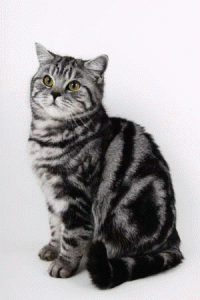Do you remember the Cheshire cat in Alice in Wonderland? Have you ever noticed the silver tabby on Whiskas? The blue cat on Sheba packages?
Well, unquestionably the British Shorthair is a popular breed:
History
The ancestors of the British Shorthair were brought to England during the Roman period. Originally they were used as working cats, catching rodents.
In 1870, Harrison Weir, father of the Cat Fancy conceived the idea to hold a Cat Contest. Arrangements were settled and in 1871 the first official cat show was held in Chrystal Palace. The Best in Show prize was awarded to a 14 years old female blue tabby British Shorthair, owned by Mr. Weir himself.
World War I brought a dramatic slowdown to the cat fancy in England. By its end, the interest in pedigreed cats was regained, but breeders had difficult time finding worthy, registered British Shorthair to work with. They therefore began to outcross them with Persians. However, since the British Shorthair was an established breed, the Council of the Cat Fancy objected and ruled that these hybrids could not be registered or shown as British Shorthairs. It took three generations of breeding for these cats to regain the official breed standards and be eligible for registration as British Shorthairs.
During World War II the breeds drama repeated and it wasn’t until 1980 that the Cat Fanciers Association granted the British Shorthair Championship status and its populary started regaining ground.
Personality
British Shorthairs are an easygoing breed of cat. They have a stable character and take well to being kept as indoor cats, making them ideal for apartment living. They are especially gentle and placid around children and other domestic animals and do not make noise, unless there is something really wrong, like they are hungry.
The Brits are wonderful cats for people who work full-time, as they are fairly independent and happy to amuse themselves while you are out. As kittens they are playful, however adult British Shorthairs tend to be less active than the other breeds. Although quiet, these intelligent creatures are very affectionate, confident and good natured.
Brits can be quite shy to begin with, but when they become more familiar with their surroundings they are extremely loyal pets. Many cats of other breeds tend to bond with just one person in a family rather than everyone, but British Shorthairs show their affection to the whole household.
Breed standards
According to the Fédération Internationale Féline, the British Shorthairs possess a medium to large overall appearance. Their head is round and massive with a broad skull and a strong chin. Their nose is short, broad and straight with a slight indentation, however not with a stop as in the “Exotic“. Their ears are small and slightly rounded at the tips, set wide apart.
- White
- Black/Blue/Chocolate/Lilac/Red/Cream
- Black/Blue/Chocolate/Lilac tortie
- Smoke
- Black/Blue/Chocolate/Lilac tortie
- Golden shaded/shell
- Tabby
- Silver tabby
- Golden tabby
- Van/Harlequin/Bicolour
- Van/Harlequin/Bicolour smoke
- Van/Harlequin/Bicolour tabby
- Van/Harlequin/Bicolour silver tabby
- Colourpoint
- Tabby point colourpoint

You must be logged in to post a comment.